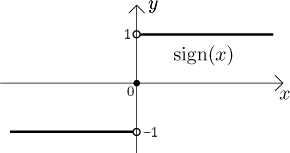Definition.
The sign function is defined for real numbers by

The sign functions is some sort of a flag that shows what sign a given number has.
Definition.
The sign function is defined for real numbers by
The graph:

Some people use another notation,
One particular application of the sign function is problems with absolute
value, since we can write
Fact.
If f,g are functions and f is differentiable, then we have
[f⋅sign(g(x))]′ = f ′⋅sign(g(x)) at points x such that g is not zero on some neighborhood of x.
In particular, we can write
Sometimes we do not even have to worry. In some settings, the value of
functions at individual points do not matter (like in integral
transformations). Then we can simply use